November 5th Scots’ Book of Days– 1562 Battle of Corrichie.
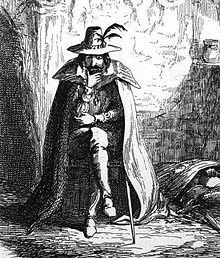 November 5 – 1562 Battle of Corrichie. Rebel Earl of Huntly and the royal troops. Sir John Wishart distinguished.
November 5 – 1562 Battle of Corrichie. Rebel Earl of Huntly and the royal troops. Sir John Wishart distinguished.
1605 Guy Fawkes day. Fawkes reportedly had 10 years of military experience fighting in the Spanish Netherlands in suppression of the Dutch Revolt. Captured after having been given charge of the explosives, guarding 36 barrels of gunpowder, the Bonfire Night commemoration. London, Parliament.
George Cruikshank’s illustration of Guy Fawkes, published in William Harrison Ainsworth’s 1840 novel. Gunpowder Plot: A conspiracy led by Robert Catesby to blow up the English Houses of Parliament is thwarted when Sir Thomas Knyvet, a justice of the peace, finds Guy Fawkes in a cellar below the House of Lords. Pre union of parliaments, but post union of the crowns.
The Gunpowder Plot – 1605. Two years after Scot’s king taking the throne, a group of disaffected English Catholics led by Robert Catesby attempted to assassinate James and the leading Protestant nobles by blowing up the Houses of Parliament. The plot failed and the conspirators were executed. Video: A history of Scotland: Project Britain.
http://www.bbc.co.uk/scotland/history/the_reformation/the_gunpowder_plot/
 1688 – The Glorious Revolution begins: William of Orange lands at Brixham. Steering for the west of England, the Prince of Orange landed in Torbay, on the 5th November 1688, being the anniversary of the Gunpowder Plot, [TG54-319]. William III of England arrived at Brixham in England on 5 November (Julian calendar), after setting sail from the Netherlands on 11 November (Gregorian calendar), note the week back ward time.
1688 – The Glorious Revolution begins: William of Orange lands at Brixham. Steering for the west of England, the Prince of Orange landed in Torbay, on the 5th November 1688, being the anniversary of the Gunpowder Plot, [TG54-319]. William III of England arrived at Brixham in England on 5 November (Julian calendar), after setting sail from the Netherlands on 11 November (Gregorian calendar), note the week back ward time.
Equestrian portrait of William III (3rd of England and 2nd of Scotland) by Jan Wyck, commemorating the landing at Brixham, Torbay, 5 November 1688
William of Orange invades – 1688. William lands a large Dutch force in Brixham, Devon. Defeated and captured, James VII is allowed to escape to France. Parliament states that with this act James has abdicated and William and his Stuart wife, Mary, are declared King and Queen. The Scots are not consulted. Video: A history of Scotland: God’s Chosen People.
http://www.bbc.co.uk/scotland/history/covenanters/william_of_orange_invades/
Ends the Killing time.
1701 Charles Gerard, 2nd Earl of Macclesfield died (ca. 1659 – 5 November 1701) was born in France and was naturalized in England by act of Parliament in 1677. Concerned in the intrigues of the duke of Monmouth; in 1685 he was sentenced to death for being a party to the Rye House Plot, but was pardoned by the king (James 7th). In 1689 he was elected Member of Parliament for Lancashire, A major-general in the same year, Macclesfield saw some service abroad; and in 1701, he was selected first commissioner for the investiture of the elector of Hanover (afterwards King George I) with the Order of the Garter, on which occasion he also was charged to present a copy of the Act of Settlement to the dowager electress Sophia.
 1745 – three MacDonald regiments, Glengarry’s, Clanranald’s, and Keppoch’s, with Elcho and Pitsligo’s horse; this division was commanded by the Prince in person. After halting two days at Kelso, they marched to Jedburgh, thus taking a turn towards the west. Their original demonstration to the eastward, was designed to alarm Marshal Wade, and to prevent his taking any measures for moving towards Carlisle, their real object of attack. [TG79-207]
1745 – three MacDonald regiments, Glengarry’s, Clanranald’s, and Keppoch’s, with Elcho and Pitsligo’s horse; this division was commanded by the Prince in person. After halting two days at Kelso, they marched to Jedburgh, thus taking a turn towards the west. Their original demonstration to the eastward, was designed to alarm Marshal Wade, and to prevent his taking any measures for moving towards Carlisle, their real object of attack. [TG79-207]
Map showing relative locations of Kelso, north of Jedburgh, and Carlisle.
1788 – friends to constitutional liberty proposed that the return of the day should be solemnized by an agreement to erect a monument to the memory of King William. [TG59-49] Monument abandoned “that a dead fly will pollute a rich and costly unguent.”
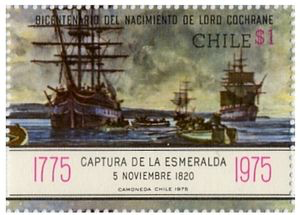 1820 Lord Cochrane Captures the Esmeralda. (clans Cochrane and Blair) later 10th Earl of Dundonald. Vice-Admiral of Chile, and Commander-in-Chief of the Naval Forces of the Republic of Chile succeeded in taking the well-fortified Spanish stronghold of Valdivia in support of the Chilean War of Independence against the Spanish Empire,
1820 Lord Cochrane Captures the Esmeralda. (clans Cochrane and Blair) later 10th Earl of Dundonald. Vice-Admiral of Chile, and Commander-in-Chief of the Naval Forces of the Republic of Chile succeeded in taking the well-fortified Spanish stronghold of Valdivia in support of the Chilean War of Independence against the Spanish Empire,
Chile Captua de la Esmeralda 5 Novembre 1820, 1775-1975 postage stamp. Bicentenial del Nacimento de Lord Cochrane.
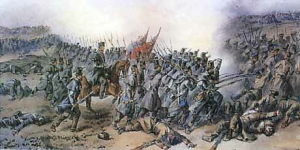 1854 The Battle of Inkerman. Crimean War, Ukraine. 21st Royal North British Fusiliers, now the Royal Highland Fusiliers (7 officers and 114 men). Coldstream Guards (13 officers and 181 men.)
Scots Fusilier Guards, now the Scots Guards
(casualties 9 officers and 168 men). 1st Regiment, the Royal Regiment, now the Royal Scots. 21st Royal Scots Fusiliers holding the Barrier against
Russian attack at the Battle of Inkerman.
1854 The Battle of Inkerman. Crimean War, Ukraine. 21st Royal North British Fusiliers, now the Royal Highland Fusiliers (7 officers and 114 men). Coldstream Guards (13 officers and 181 men.)
Scots Fusilier Guards, now the Scots Guards
(casualties 9 officers and 168 men). 1st Regiment, the Royal Regiment, now the Royal Scots. 21st Royal Scots Fusiliers holding the Barrier against
Russian attack at the Battle of Inkerman.
The Return from Inkerman by Lady Butler. Royal Academy in 1874. Her picture depicts soldiers of the Coldstream Guards and the 20th Regiment trudging back from the battle.
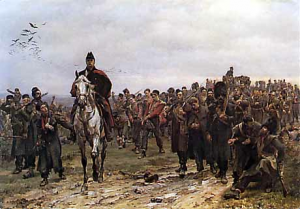 Corporal McDermond of the 47th Regiment winning the
Victoria Cross by saving his wounded colonel from the Russians.
Corporal McDermond of the 47th Regiment winning the
Victoria Cross by saving his wounded colonel from the Russians.
. 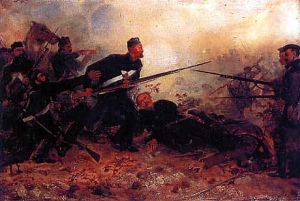 http://www.britishbattles.com/crimean-war/inkerman.htm
http://www.britishbattles.com/crimean-war/inkerman.htm
1879 James Maxwell died. Maxwell is also known for presenting the first durable colour photograph in 1861 and for his foundational work on the rigidity of rod-and-joint frameworks like those in many bridges. James Clerk Maxwell was born 13 June 1831 at 14 India Street, Edinburgh, to John Clerk, an advocate, and Frances Cay. Maxwell’s father was a man of comfortable means, of the Clerk family of Penicuik, Midlothian, holders of the baronetcy of Clerk of Penicuik; his brother being the 6th Baronet. James was the first cousin of notable 19th century 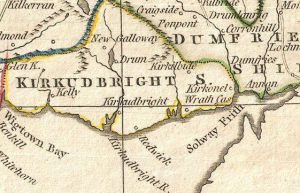 artist Jemima Blackburn. He had been born John Clerk, adding the surname Maxwell to his own after he inherited a country estate in Middlebie, Kirkcudbrightshire from connections to the Maxwell family, themselves members of the peerage.
artist Jemima Blackburn. He had been born John Clerk, adding the surname Maxwell to his own after he inherited a country estate in Middlebie, Kirkcudbrightshire from connections to the Maxwell family, themselves members of the peerage.
1799 map showing kirkudbright Shire on the Solway Frith.
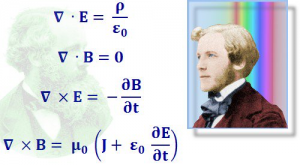 By the age of three, everything that moved, shone, or made a noise drew the question: “what’s the go o’ that?”. In the millennium poll—a survey of the 100 most prominent physicists—Maxwell was voted the third greatest physicist of all time, behind only Newton and Einstein.
By the age of three, everything that moved, shone, or made a noise drew the question: “what’s the go o’ that?”. In the millennium poll—a survey of the 100 most prominent physicists—Maxwell was voted the third greatest physicist of all time, behind only Newton and Einstein.
Younger James Clerk Maxwell with equations.
 Elderly James Clerk Maxwell (1831–1879) – Maxwell’s equations, Maxwell distribution, Maxwell’s theorem, Displacement current, polarized light, Maxwell left Scotland for Cambridge University. He initially attended Peterhouse, but before the end of his first term transferred to Trinity College, where he believed it would be easier to obtain a fellowship. At Trinity, he was elected to the elite secret society known as the Cambridge Apostles. Maxwell took the coloured spinning tops invented by Forbes, and was able to demonstrate that white light would result from a mixture of red, green and blue light, which became the basis for color television’s red, green and blue pixels a century later.
Elderly James Clerk Maxwell (1831–1879) – Maxwell’s equations, Maxwell distribution, Maxwell’s theorem, Displacement current, polarized light, Maxwell left Scotland for Cambridge University. He initially attended Peterhouse, but before the end of his first term transferred to Trinity College, where he believed it would be easier to obtain a fellowship. At Trinity, he was elected to the elite secret society known as the Cambridge Apostles. Maxwell took the coloured spinning tops invented by Forbes, and was able to demonstrate that white light would result from a mixture of red, green and blue light, which became the basis for color television’s red, green and blue pixels a century later.
Maxwell ancestry; John Maxwell, Master of Maxwell, died 22 July 1484, married circa 1454 Janet Crichton, had è
17F Janet Maxwell married Sir William Carlyle, 2nd Lord Carlyle of Torthorwald born before 1477, died 22 Feb 1523 had –> (Best candidate for Carlyle of Torthorwald) 17F Carlyle of Torthorwald had –>,
16M Elizabeth Carlisle 1510-1547 married Robert 3rd Lord Semple 1501-1572 The Great Lord had –>
15M Dorothea Semphill married Robert 6th Lord Montgomerie had
14M Elizabeth Montgomery married William De Cochrane had
13M Elizabeth Cochrane, Paisley, married 13F Alexander Blair
12F Hugh Cochrane, (Dictionary of National Biography xvii, 1200) 1609 of Ferguslie, and Colonel under Gustavus Adolphus the Great King Sweden married 12M Jean Savage, (daughter of Hugh Savage, of county Down Ireland), had
11M Grizel Cochrane, married 5 December 1671 in Ochiltree, Ayr, as 2nd wife to 11F Robert Miller 1st had
10F Robert Miller 2nd 10F, (christened 28 Jun 1678-1732) of St Quivox Scotland, Presbyterian minister, married Helen Meldrum 10M had
9F Robert Miller 3rd , (b.1730 Scotland) immigrated to South Carolina and married Jane Pickens 9M had,
8M Annie Miller (1762-1843) and Lt. Robert Simmons, 8F War of Independence, had
7F John Simmons married 1815 Naomi Jared 7M had
6F Joseph Pickens Simmons married 6M Francis Virginia Mason, had
5M Mary Elizabeth Simmons married Austin Choate 5F, and left a large posterity in America.
TWO OTHER MAXWELL LINES
Sir John Maxwell Lord dominus of Maxwell[1] had
Robert de Maxwell of Carlaverock d 1373 had
Agnes Maxwell married Gilbert Kennedy Knight 1348 had Sir James Kennedy 1376-1408 of Dunure Ayr, married Mary Stewart Princess had Gilbert 1st Lord Kennedy 1406-1478 married Catherine Maxwell Baroness Kennedy had Catherine Kennedy married Alexander 2nd Lord Montgomerie had Hugh Montgomerie 1st Earl Eglinton (1460-1545) 3rd Baron Montgomerie, Laird of Ardrossan 1484, Justice General of Northern Scotland 1526, and Council of Regency 1536,md Helen Campbell had 15M Elizabeth Montgomery married 15F John Blair II 2nd had 14F John Blair 3rd of Blair (died 1609) married his 1st cousin once removed, 14M Grizel Semple, daughter of Robert 3rd Lord Sempill had 13F Alexander Blair, from Blair of Blair, married 13M Elizabeth Cochrane, Paisley, Renfrewshire, had numerous posterity.
- Blair Ilk 1205 2Cochrane2Miller 2Simmons2Choate zoe ToaG
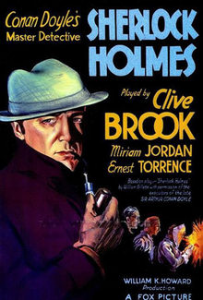 1887 John Reginald Owen (5 August 1887 – 5 November 1972) died, he was a British character actor. Owen is perhaps best known today for his performance as Ebenezer Scrooge [a fictional Scot] in the 1938 film version of Charles Dickens’ A Christmas Carol. Owen was the first of only four actors to play both Sherlock Holmes and his companion Dr Watson. Owen first played Watson in the film Sherlock Holmes (1932), and then Holmes himself in A Study in Scarlet (1933). Having played Ebenezer Scrooge, Sherlock
1887 John Reginald Owen (5 August 1887 – 5 November 1972) died, he was a British character actor. Owen is perhaps best known today for his performance as Ebenezer Scrooge [a fictional Scot] in the 1938 film version of Charles Dickens’ A Christmas Carol. Owen was the first of only four actors to play both Sherlock Holmes and his companion Dr Watson. Owen first played Watson in the film Sherlock Holmes (1932), and then Holmes himself in A Study in Scarlet (1933). Having played Ebenezer Scrooge, Sherlock
Holmes and Dr. Watson, Owen has the odd distinction of playing three classic characters of Victorian fiction.
1932 American film Sherlock Holmes., Owen as Watson.
 1892 – J. B. S. Haldane, Scottish geneticist (d. 1964). Haldane
1892 – J. B. S. Haldane, Scottish geneticist (d. 1964). Haldane
Crest: An eagle’s head erased Or Motto: SUFFER. Chief: Martin Haldane of Gleneagles Seat: Gleneagles, Perthshire
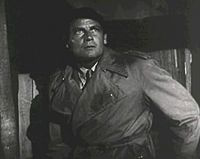 1905 Joel Albert McCrea born. Scots ancestry. 90 films. Died Oct 20, 1990.
1905 Joel Albert McCrea born. Scots ancestry. 90 films. Died Oct 20, 1990.
Joel McCrea as “Huntley Haverstock”, foreign correspondent, released August 16, 1940. Joel McCrea’s work ethic was in part attributed to his Scottish heritage and it also may have stemmed from his friendship in the 1930s with fellow personality and sometime actor, Will Rogers (quarter Cherokee, Rogers’ side was Scots). McCrea recounted that “the Oklahoma Sage” gave him a profound piece of advice: “Save half of what you make, and live on just the other half.”[9] Wikipedia.
 1943 The auld Army Game is a Walt Disney cartoon starring Donald Duck (fictional clan McDuck).
1943 The auld Army Game is a Walt Disney cartoon starring Donald Duck (fictional clan McDuck).
1948 centennial Fort Bliss El Paso Texas. Space commemorative.
1960 Katherine Matilda “Tilda” Swinton of Kimmerghame (born 5 November 1960) is a British actress. She won the Best Supporting Actress Oscar in 2008 for her role as a lawyer in Michael Clayton.
Read more at http://www.dailyrecord.co.uk/whats-on/film-news/scotlands-forgotten-oscars-how-three-5085589#eiylxtf16w4L6AJU.99. 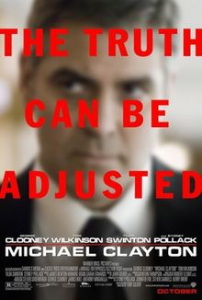 Her father Major General Sir John Swinton of Kimmerghame is the son of Brigadier Alan Henry Campbell Swinton of Kimmerghame, MC (born 15 March 1896)[1][2][3][4][5] and wife, Mariora Beatrice Evelyn Rochfort Alers-Hankey (born 1900). His paternal grandfather was Scottish politician and officer-of-arms George Swinton. The Swinton family is an ancient Anglo-Scots family that can trace its lineage to the High Middle Ages.[5]
Her father Major General Sir John Swinton of Kimmerghame is the son of Brigadier Alan Henry Campbell Swinton of Kimmerghame, MC (born 15 March 1896)[1][2][3][4][5] and wife, Mariora Beatrice Evelyn Rochfort Alers-Hankey (born 1900). His paternal grandfather was Scottish politician and officer-of-arms George Swinton. The Swinton family is an ancient Anglo-Scots family that can trace its lineage to the High Middle Ages.[5]
John was commissioned into the Scots Guards in 1944 and wounded. Film poster 2007.
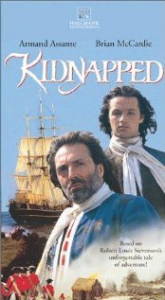 1995 Kidnapped film released. Scottish boy gentleman fictional David Balfour’s father dies, David leaves school to collect his inheritance from uncle Ebenezer, who in turn sells David as a slave to a pirate ship. When staunch Stuart dynasty supporter Alan Breck Stewart (real historical figure) accidentally boards the ship, Alan takes David along on his escape back to Edinburgh. They part and meet again repeatedly, mutually helpful against the Redcoats and respectful, although David is loyal to the English crown, but learns about its cruel oppression.
1995 Kidnapped film released. Scottish boy gentleman fictional David Balfour’s father dies, David leaves school to collect his inheritance from uncle Ebenezer, who in turn sells David as a slave to a pirate ship. When staunch Stuart dynasty supporter Alan Breck Stewart (real historical figure) accidentally boards the ship, Alan takes David along on his escape back to Edinburgh. They part and meet again repeatedly, mutually helpful against the Redcoats and respectful, although David is loyal to the English crown, but learns about its cruel oppression.
1995 film poster Robert Louis Stevenson’s novel.
2012 Humor. Lindsay was roaming in the highlands, hoping to find a short cut, back route, in order to file some papers at the Society, and return back south the same afternoon. Disoriented, lost, and unable to decipher the map, Lindsay saw a farmer, rocking on the front porch. Pulling up, Lindsay asked directions, and was satisfied, but, before he left with directions, started a persiflage. ‘Aye, wha kinna farrrrmerrrrr are ye?’ The farmer replied ‘Pig farrrrmerrrrr’. ‘Ye dinnae say? Always wondered hae long it takes tae fatten a pig for marrrrrket?’ The farmer replied ‘Twa yearrrrrrs.’ Lindsay’s eyebrows raised, ‘Twa yearrrrrs? Sounds like a lang time.’ Then, the farmer’s eyebrows creased, ‘Whae’s time tae a pig?’ the farmer asked?
Disclaimer: The author of each article published on this web site owns his or her own words. The opinions, beliefs and viewpoints expressed by the various authors and forum participants on this site do not necessarily reflect the opinions, beliefs and viewpoints of Utah Standard News or official policies of the USN and may actually reflect positions that USN actively opposes. No claim in public domain or fair use. © John Choate
[1] Sir John Maxwell, Lord (dominus) of Maxwell, his son, probably did not for a time regain possession of Carlaverock. Roger de Kirkpatrick had in the end of 1356 taken the castle of Carlaverock and leveled it with the ground, and when residing in the neighbourhood, was, in June following, assassinated by Sir James Lindsay. Sir John Maxwell sat in the meeting of the Estates at Edinburgh
26th September 1357, when the terms proposed by Edward III. relative to the release of David II. were agreed to, and he was engaged in the negotiations relating thereto.
Utah Standard News depends on the support of readers like you.
Good Journalism requires time, expertise, passion and money. We know you appreciate the coverage here. Please help us to continue as an alternative news website by becoming a subscriber or making a donation. To learn more about our subscription options or make a donation, click here.
To Advertise on UtahStandardNews.com, please contact us at: ed@utahstandardnews.com.


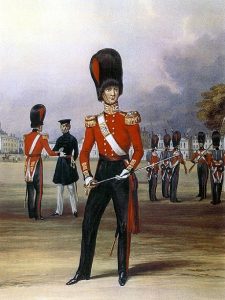

Comments - No Responses to “November 5th Scots’ Book of Days– 1562 Battle of Corrichie.”
Sure is empty down here...